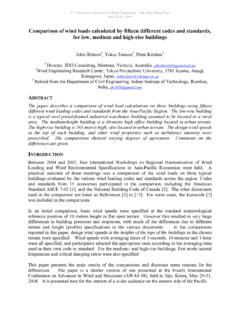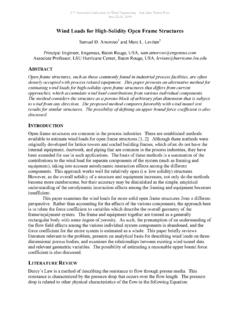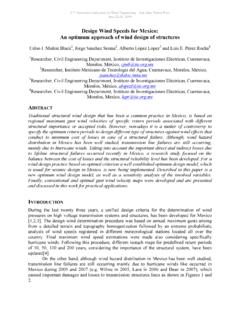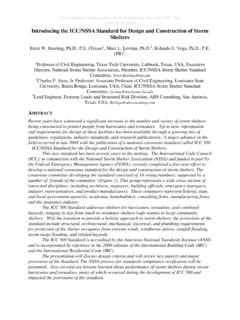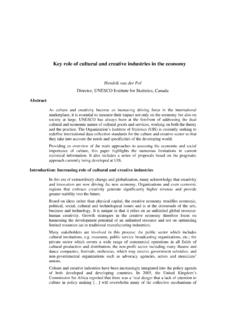Transcription of ANALYSIS AND DESIGN OF RC TALL BUILDING …
1 The Eighth Asia-Pacific Conference on Wind Engineering,December 10 14, 2013, Chennai, India ANALYSIS AND DESIGN OF RC tall BUILDING SUBJECTED TO WIND AND EARTHQUAKE LOADS K. Rama Raju*,1, Shereef3, Nagesh R Iyer2, S. Gopalakrishnan4 1 Chief Scientist, 2 Director, 3 Project Student, CSIR-Structural Engineering Research Centre, Chennai-600113, 4 Professor, K S Rangasamy College of Technology, Tiruchengode-637215. ABSTRACT Consideration of site specific lateral loading due to wind or earthquake loads along with vertical gravity loads is important for finding the behavior of the tall buildings. As the height of a BUILDING becomes taller, the amount of structural material required to resist lateral loads increases drastically. The DESIGN of tall buildings essentially involves a conceptual DESIGN , approximate ANALYSIS , preliminary DESIGN and optimization, to safely carry gravity and lateral loads. The DESIGN criteria are strength, serviceability and human comfort.
2 The aim of the structural engineer is to arrive at suitable structural schemes, to satisfy these criteria. In the present study, the limit state method of ANALYSIS and DESIGN of a 3B+G+40-storey reinforced concrete high rise BUILDING under wind and seismic loads as per IS codes of practice is described. Safety of the structure is checked against allowable limits prescribed for base shear, roof displacements, inter-storey drifts, accelerations prescribed in codes of practice and other relevant references in literature on effects of earthquake and wind loads on buildings. Keywords: tall buildings, seismic loads, wind loads, response spectrum method, gust factor method. Introduction In general, for DESIGN of tall buildings both wind as well as earthquake loads need to be considered. Governing criteria for carrying out dynamic analyses for earthquake loads are different from wind loads. According to the provisions of Bureau of Indian Standards for earthquake load, IS 1893(Part 1):2002, height of the structure, seismic zone, vertical and horizontal irregularities, soft and weak storey necessitates dynamic ANALYSIS for earthquake load.
3 The contribution of the higher mode effects are included in arriving at the distribution of lateral forces along the height of the BUILDING . As per IS 875(Part 3):1987, when wind interacts with a BUILDING , both positive and negative pressures occur simultaneously, the BUILDING must have sufficient strength to resist the applied loads from these pressures to prevent wind induced BUILDING failure. Load exerted on the BUILDING envelope are transferred to the structural system and they in turn must be transferred through the foundation into the ground, the magnitude of the wind pressure is a function of exposed basic wind speed, topography, BUILDING height, internal pressure, and BUILDING shape. The main objective of this study is to carry out the ANALYSIS of 3B+G+40 multi stored residential BUILDING against earthquake and wind loads as per Indian standard codes of practice IS 1893(Part 1):2002 and IS 875(Part 3):1987.
4 First, the sensitivity of base shear of the BUILDING with respect to the location of the BUILDING at different wind zones in India is investigated. The wind loads and earthquake loads on the BUILDING are calculated assuming the BUILDING to be located at Mumbai. The member forces are calculated with load combinations for Limit State Method given in IS 456: 2000 and the members are designed for the most critical member forces among them. The BUILDING is subjected to self weight, dead load, live load as per IS 875(Part 1, Part 2):1987. Safety of the structure is checked against allowable limits prescribed for base shear, roof displacements, inter-storey drifts and accelerations in codes of practice and other references in literature on effects of earthquake and wind loads on buildings. Proc. of the 8th Asia-Pacific Conference on Wind Engineering Nagesh R.
5 Iyer, Prem Krishna, S. Selvi Rajan and P. Harikrishna (eds)Copyrightc 2013 APCWE-VIII. All rights byResearch Publishing, Singapore. ISBN: 978-981-07-8011-1 of the 8th Asia-Pacific Conference on Wind Engineering (APCWE-VIII) DESCRIPTION OF BUILDING model In the present study, an RCC 3B+G+40 storeyed residential BUILDING model and its loading conditions are taken from INSDAG report (2007). The general features of the BUILDING model and beam sections used in the BUILDING are given in Table 1. Table 1 General features of the model structure Length Width Height Thickness Beam schedule (including basement) BF (3 nos.) GF TFRF* Slab 27 5 : B2 : Note: Basement Floor(BF),Ground Floor (GF), Typical Floor(TF), Refuge Floor (RF), Shear Wall (SW), *10th, 20th and 30th floors are designed as refuge floors; All units are in m The BUILDING has been provided with wall type RCC columns having rectangular, L, Tee and Star shapes of varying sizes.
6 The grades of reinforcing steel and concrete used in the BUILDING are assumed to be of Fe500 and M35 respectively. The material properties used for concrete and steel are given in the Table 2. The dimensions of the rectangular, L, Tee and Star sections are given in Table 3 and the prismatic general section properties of L, Tee and Star column sections given as input to BUILDING model are given in Table 4. The plan of the BUILDING model indicating the Beam and Column schedule is shown in Figure 1. Table 3 Column schedule Column C1 C2 C3 C4 C5 Basement to 5th floor to 10th floor 11th floor to roof Note:C1 and C2 are rectangular sections, For all sections units are in m Table 4 Prismatic general sections of Sections L, Tee and Star sections C3 C4 C5 A(m2) Iyy(m4) Izz(m4) J(m4) A(m2) Iyy(m4) Izz(m4) J(m4) A(m2) Iyy(m4) Izz(m4) J(m4) MODELING OF LOADS The basic loads considered in this study are dead load, live loads, earthquake loads and wind loads.
7 The values of Dead loads (DL) are calculated from the unit weights as specified in IS 875 (Part 1): 1987. The live load (LL) intensities for the various areas of residential buildings are obtained from IS 875 (Part 2): 1987. The summary of dead load and live loads considered for the BUILDING is given in Table 5. In load combinations involving Imposed Loads (LL), IS 1893 (Part I):2002 recommends for loads up to and including 3 kN/m2, 25% of the imposed load to be considered for seismic weight calculations. However to be conservative, in the present study, 100% imposed loads are considered in load combinations. The earthquake loads are assigned in X and Y directions as ELx and ELy respectively as per IS 1893(Part 1): 2002. Table 2 Material property Property Concrete Steel Young's Modulus, E (kN/mm2) 205 Poisson's ratio( ) Density, (Kg/m3) 845 Proc.
8 Of the 8th Asia-Pacific Conference on Wind Engineering (APCWE-VIII) ANALYSIS ANALYSIS of 3B+G+40 storeyed RC BUILDING has been done considering the entire structure as a 3D moment resisting frame with brick infill panels using package. Beam and columns are considered as beam elements. The slabs are considered as plate elements. There are 2710 number of joints and 7585 elements in the ANALYSIS model of the structure. The main objective of modeling the whole structure as 3D model is to take into account the behavior of each and every component in space structure environment. The slab is modeled as an element to carry the live load as distributed pressure load. Lift well and staircase walls are modeled as shear wall to resist the lateral loads like wind and earthquake load. Plate elements are used for shear walls. From the ANALYSIS , the natural frequencies and time periods in first 20 modes are found to be , , , , , , , , , , , , , , , , , , and, , , , , , , , , , , , , , , , , , , and sec respectively.
9 :All Dimensions are in 'm' Figure 1. Plan of the model Table 5 Dead Load and Live Loads Load description Value Superimposed load on each floor Finish load kN/m2 Live load kN/m2 Wall load with hollow bricks - 240 mm thick external wall kN/m - 125 mm thick internal wall KN/m kN/m Intensity of superimposed load over refuge floor Finish load kN/m2 Live load kN/m2 Additional service load over roof top Water proofing load kN/m2 Live load kN/m2 Service load kN/m2 Overhead reservoir load (Column load at the column of shear wall) 500 kN 846 Proc. of the 8th Asia-Pacific Conference on Wind Engineering (APCWE-VIII) ANALYSIS of BUILDING for Earthquake Loads as per IS 1893(Part-1):2002 The equivalent static ANALYSIS also known as the equivalent lateral force procedure or seismic coefficient method (SCM) is used for finding the response of the structures to earthquake loads.
10 In this ANALYSIS , first the base shear along X- or Y- direction is calculated in terms of a spectral acceleration coefficient, the weight of the BUILDING and a few other variables. In seismic coefficient method, the total DESIGN seismic base shear ( B) calculated as per clause of IS 1893(Part 1): 2002. The plan of the 3B+G+40 storeyed RC BUILDING considered is unsymmetrical and it is assumed to be not sensitive to torsion. Since, the BUILDING is modeled as moment resisting frame with brick infill, the time periods in X- and Y- direction are calculated using the approximate formula given in Clause , , where, h is height of the BUILDING , in m and d is base dimension of the BUILDING at plinth level, in m, along the considered lateral force. For the present BUILDING , time period in X- and Y-direction is found to be and respectively. The data used for the seismic ANALYSIS are; importance factor, I= , response reduction factor, R=3.
